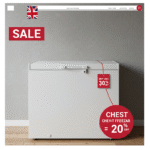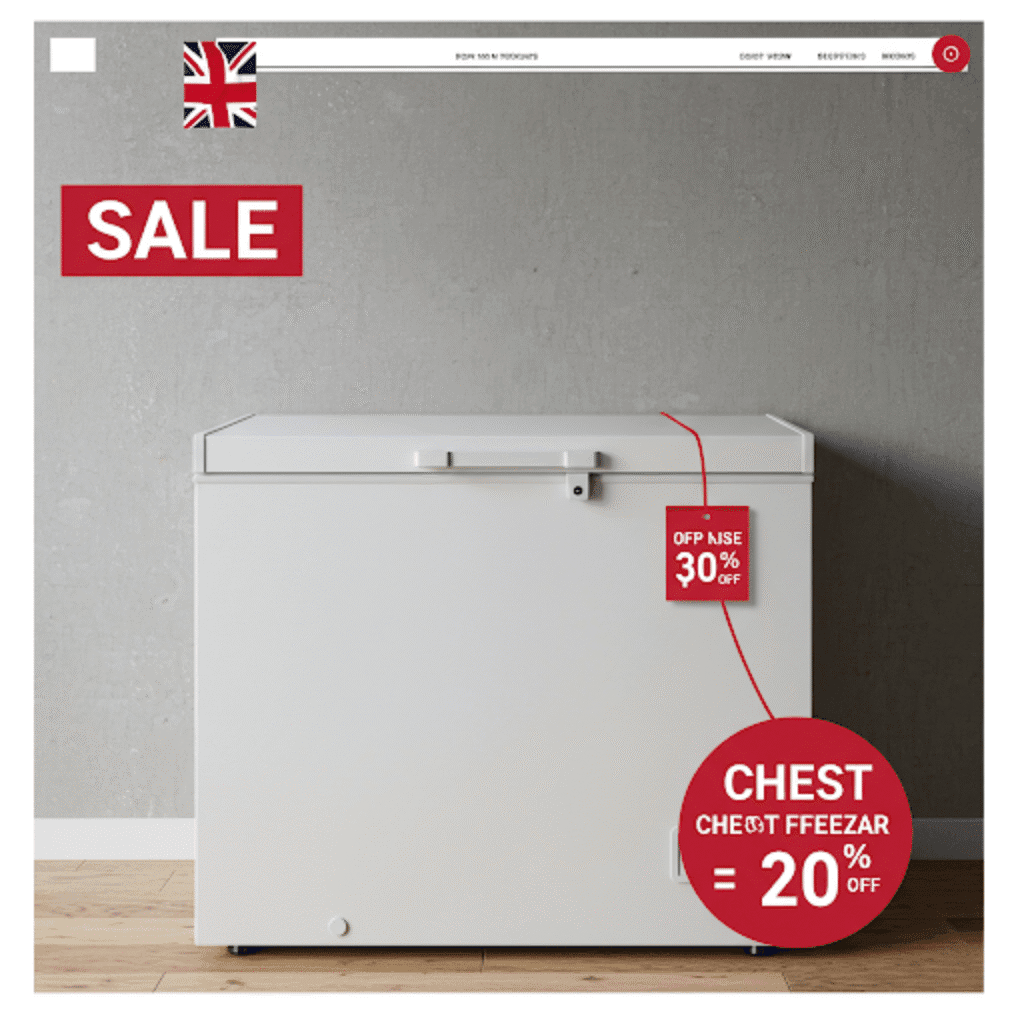
Unlock Deep Freeze Savings: Your Ultimate Guide to Finding the Best Chest Freezer Sale
In today’s world, where managing household budgets and making smart food choices are paramount, finding ways to save money and reduce waste is always welcome. Enter the humble chest freezer – a surprisingly versatile and cost-effective appliance that can transform how you shop, cook, and store food. While the initial outlay might seem like another expense, timing your purchase during a chest freezer sale can unlock significant savings, making this incredibly useful appliance even more accessible. Whether you’re a keen gardener wanting to preserve your harvest, a bulk-buying bargain hunter, a busy parent batch-cooking for the week, or simply someone looking for extra freezer space, this guide will navigate you through the world of chest freezers and help you snag the perfect model at the perfect price.
What Exactly is a Chest Freezer, and Why Should You Care?
Unlike its upright sibling, a chest freezer, as the name suggests, is typically a large, box-like appliance with a hinged lid on top. You access the contents by reaching down into the storage space. While this design might seem less convenient at first glance compared to the shelved layout of an upright freezer, it comes with several distinct advantages, particularly when it comes to energy efficiency and maximising usable storage volume.
The design inherently helps retain cold air. When you open the lid, the dense, cold air tends to stay settled at the bottom, unlike an upright freezer where cold air spills out more readily each time the door is opened. This characteristic often translates into lower running costs and better temperature stability, especially during power outages where a well-stocked chest freezer can keep food frozen for longer periods.

The Chilling Benefits: More Than Just Extra Space
Investing in a chest freezer, especially when found during a great sale, offers a cascade of benefits that extend far beyond simply having more room for frozen peas:
- Bulk Buying Power: This is perhaps the most significant advantage. Chest freezers allow you to take full advantage of supermarket deals, butcher specials, and wholesale club offers on meat, poultry, frozen vegetables, and more. Buying in bulk almost always means a lower price per unit, leading to substantial savings on your grocery bills over time.
- Batch Cooking Bonanza: Prepare large quantities of meals like casseroles, soups, stews, curries, and pasta sauces when you have the time, then freeze individual or family-sized portions. This is a lifesaver for busy weeknights, saving you time, effort, and the temptation of expensive takeaways.
- Preserve the Harvest: For those with green fingers, a chest freezer is indispensable for preserving the bounty from your garden or allotment. Freeze fruits, vegetables, and herbs at their peak freshness to enjoy homegrown goodness all year round.
- Reduce Food Waste: Got leftovers? Don’t let them languish in the fridge. Freeze them for another day. Found bread nearing its best-before date? Pop it in the freezer. A chest freezer helps you save food that might otherwise end up in the bin, saving you money and helping the environment.
- Emergency Preparedness: Having a well-stocked freezer provides peace of mind, ensuring you have food available during unexpected events, be it bad weather, illness, or unforeseen circumstances.
- Seasonal Delights Year-Round: Freeze seasonal berries in the summer to enjoy in winter crumbles, or store game meat acquired during hunting season.
- Specialised Storage: Perfect for storing large or awkwardly shaped items that might not fit easily into an upright freezer, such as a large turkey, joints of meat, or big bags of frozen chips.
Choosing Your Champion: Navigating the Features
Before you jump headfirst into a chest freezer sale, it’s crucial to know what you’re looking for. Consider these factors to ensure you choose the right model for your needs:
1. Size and Capacity: How Big Do You Need to Go?
Chest freezers come in various sizes, typically measured in litres. Think realistically about how much extra storage you genuinely need and where you plan to put the appliance.
- Compact (Under 150 litres): Ideal for smaller households, those with limited space, or primarily for storing overflow from the main fridge-freezer. Fits well in kitchens or utility rooms.
- Medium (150-300 litres): A popular choice for average-sized families, offering a good balance between capacity and footprint. Often destined for utility rooms, garages, or cellars.
- Large (Over 300 litres): Best suited for large families, keen cooks, gardeners, or those who buy significant amounts of food in bulk. Requires ample space, usually in a garage or outbuilding.
Remember to measure the intended space carefully, including allowances for ventilation (check manufacturer guidelines) and for opening the lid fully.
2. Energy Efficiency: Keeping Running Costs Low
While chest freezers are generally more energy-efficient than uprights, running costs still add up. Pay close attention to the energy label. In the UK and EU, appliances now use an A to G rating scale, with A being the most efficient. While an A-rated model might have a higher purchase price during a sale, its lower running costs could save you money in the long run. Look for the estimated annual energy consumption (kWh per year) on the label to compare models accurately.
3. Key Features to Look For:
- Baskets and Dividers: Essential for organisation! Most chest freezers come with at least one sliding basket for smaller or frequently used items. Additional baskets or dividers can be very helpful in preventing items from getting lost in the depths.
- Counterbalanced Lid: This feature holds the lid open securely at various angles, preventing it from slamming shut while you’re loading, unloading, or searching for items. It’s a significant convenience and safety feature.
- Interior Light: Illuminates the contents, making it much easier to find what you’re looking for, especially if the freezer is located in a dimly lit area like a garage or cellar.
- Temperature Alarm: An audible or visual alarm that alerts you if the internal temperature rises above a safe level, potentially saving your food from spoiling due to a malfunction or power cut.
- Fast Freeze Function: Sometimes called ‘Super Freeze’, this rapidly lowers the temperature to freeze fresh food quickly, preserving its quality, texture, and nutritional value more effectively.
- Lock: Useful for keeping the contents secure, especially if the freezer is in an accessible area or if you have curious children.
- Defrost Drain: Since most chest freezers require manual defrosting, a drain (usually at the front or side near the bottom) makes the process much less messy by allowing melted ice water to flow out easily into a container or via a hose.
4. Manual Defrost vs. Frost-Free: The Ice Question
The vast majority of chest freezers require manual defrosting. Ice builds up over time, reducing efficiency and storage space. Defrosting typically needs doing once or twice a year. While it’s a bit of a chore (involving emptying the freezer, letting the ice melt, cleaning, and reloading), it’s straightforward. Frost-free technology, common in upright freezers, automatically prevents ice build-up but is rare and significantly more expensive in chest models. It also tends to use more energy and can slightly reduce usable storage space due to the internal mechanisms.
5. Placement Considerations: Where Will It Live?
Chest freezers aren’t always designed for the main kitchen. Garages, utility rooms, sheds, and cellars are common locations. Crucially, check the manufacturer’s recommended operating temperature range. Not all freezers are designed to function correctly in very cold environments (like an unheated garage in winter) or very hot ones. Using a freezer outside its specified climate class can affect performance, increase energy consumption, and potentially shorten its lifespan. Look for models specifically designated as suitable for outbuildings if necessary.
The Thrill of the Hunt: Mastering the Chest Freezer Sale
Now for the exciting part – finding that fantastic deal! Timing and strategy are key to navigating a chest freezer sale effectively.
When Do Sales Happen?
Keep an eye out during these periods:
- Black Friday/Cyber Monday: Late November often sees significant discounts on appliances.
- January Sales: Retailers clear out old stock after Christmas.
- End-of-Line Clearances: When new models are introduced, older (but still excellent) models are often heavily discounted. This can happen at various times throughout the year.
- Seasonal Promotions: Retailers sometimes run appliance sales during spring or summer bank holiday weekends.
- Retailer-Specific Events: Sign up for newsletters from major appliance retailers to be notified of their own sales events.
Where to Look for Deals:
- Major Appliance Retailers: Currys, AO.com, Argos, John Lewis, etc. Check both their online stores and physical locations.
- Supermarkets: Larger supermarkets sometimes stock chest freezers and may include them in seasonal sales.
- Independent Electrical Retailers: Don’t overlook smaller local shops; they might offer competitive prices, bundled deals, or more personalised service.
- Price Comparison Websites: Use sites like PriceRunner or Google Shopping to compare prices across multiple retailers quickly.
- Manufacturer Websites: Occasionally, manufacturers sell direct or offer special promotions.
Top Tips for Sale Shopping Success:
- Set Your Budget: Know how much you’re willing to spend before you start looking. Factor in potential delivery costs.
- Do Your Homework: Research the models you’re interested in *before* the sale starts. Know the features you need and have a shortlist.
- Compare Prices Diligently: Don’t assume the first ‘sale’ price you see is the best. Check several retailers.
- Check Delivery and Installation: Confirm delivery costs, timescales, and whether the retailer offers installation or removal of an old appliance (and if there’s a charge).
- Read Reviews: Look for user reviews of specific models to get real-world feedback on reliability and usability.
- Warranty Matters: Check the length and terms of the manufacturer’s warranty. Some retailers might offer extended warranties, but weigh the cost versus the potential benefit.
- Understand Sale Jargon:
- Clearance: Usually end-of-line stock, perfectly new but being replaced by newer models. Often great value.
- Ex-Display: Models that have been on the shop floor. May have minor cosmetic imperfections but should be functionally sound and come with a full warranty. Inspect carefully if possible.
- Refurbished/Graded: Items that have been returned, repaired, and resold. Can offer big savings but check the warranty terms carefully and buy from reputable sellers.
Keeping Your Cool: Organising and Maintaining Your Freezer
Once you’ve bagged your bargain chest freezer, maximise its potential:
- Organise Ruthlessly: Use stackable containers, reusable freezer bags, and those included baskets. Group similar items together (e.g., meats, vegetables, batch-cooked meals).
- Label Everything: Clearly label containers and bags with the contents and the date frozen. A permanent marker is your friend!
- Keep an Inventory: Stick a list (whiteboard or paper) on or near the freezer detailing its contents. Update it as you add or remove items. This prevents forgotten food and unnecessary rummaging.
- Rotate Stock: Use the ‘First-In, First-Out’ (FIFO) principle. Place newer items at the bottom or back, and bring older items forward to use first.
- Defrost Regularly: Follow the manufacturer’s instructions for defrosting (usually when ice build-up reaches about half an inch). This maintains efficiency and storage capacity. Choose a cold day if possible, and use cool bags or boxes to store food temporarily while defrosting.
- Clean After Defrosting: Wipe down the interior with a mild food-safe cleaning solution. Ensure it’s completely dry before reloading and switching back on.
- Check Seals: Periodically inspect the lid seal for damage or gaps to ensure it’s closing tightly and maintaining efficiency.
Popular Brands in the UK Market
When Browse sales, you’ll likely encounter familiar names. Some popular and generally well-regarded chest freezer brands available in the UK include Beko, Hotpoint, Hoover, Russell Hobbs, Bush (Argos own brand), Logik (Currys own brand), Iceking, Fridgemaster, and premium options from brands like Liebherr or Miele, though these are less commonly found in typical high-street sales.
The Final Thaw: Is a Sale Chest Freezer Worth It?
Absolutely. A chest freezer is a practical, efficient appliance that empowers you to save money on groceries, reduce food waste, and enjoy the convenience of having meals and ingredients readily available. By strategically shopping during a chest freezer sale, you can acquire this valuable household asset at a significantly reduced price, amplifying the already considerable long-term savings it offers. Armed with the knowledge of what features to look for, where to find the best deals, and how to choose the right size and model for your needs, you’re well-equipped to make a smart purchase that will serve your household well for years to come. So, keep your eyes peeled for those sale banners, do your research, and get ready to unlock a world of frozen food convenience and savings.







